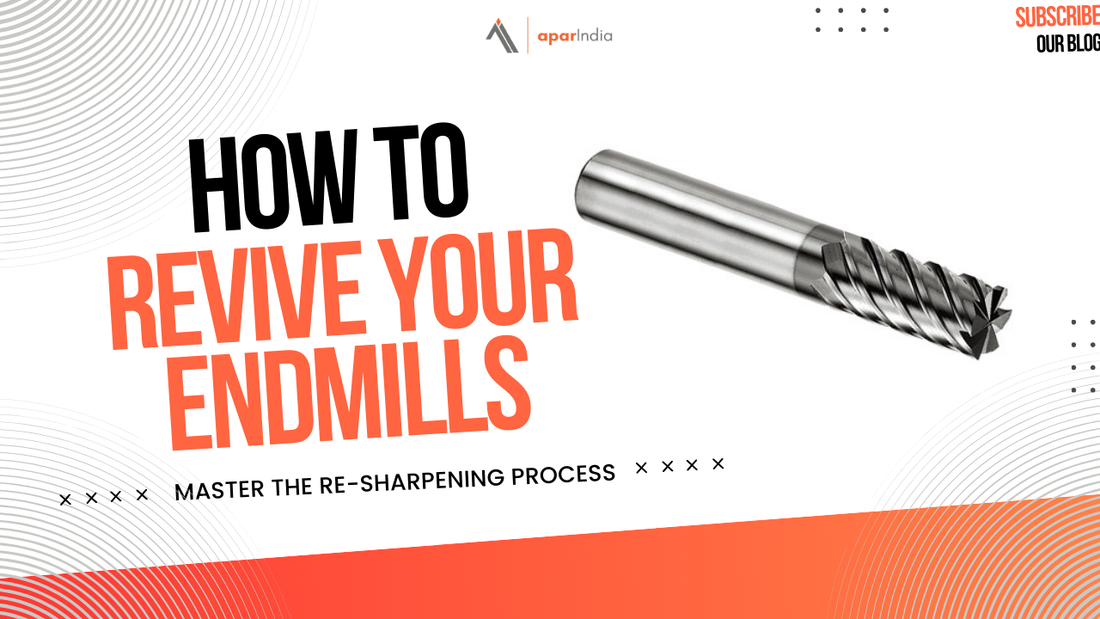
How to resharpen an endmill?
Share
Resharpening endmills is a critical process to restore their cutting performance and extend their life. The process involves several steps, and precision is key to ensuring the tool is as effective as it was when new. Here's a general outline of the steps involved:
1. Inspection
- Visual Inspection: Check for any obvious damage, wear, or chips on the cutting edges, flutes, and shank. This helps determine if resharpening is needed or if the tool is beyond repair.
- Dimensional Check: Measure the diameter, length, and overall geometry of the tool to see if it’s still within tolerance or has become worn unevenly.
2. Cleaning

- Before sharpening, clean the endmill to remove any debris, coolant, or metal particles from the cutting edges and flutes. A clean tool ensures better results during sharpening and prolongs the life of your equipment.
3. Grinding the Cutting Edges
- Flute Grinding: The primary purpose of grinding is to restore the correct geometry of the cutting edges. Each flute must be ground to the correct angle, which depends on the type of endmill (e.g., standard, ball nose, corner radius, etc.). You’ll need to ensure that the flute angle is correct to restore proper cutting performance.
- Cutting Edge: The cutting edge should be reground to maintain its sharpness and relief angles. Relief angles are crucial for reducing friction and preventing the tool from rubbing instead of cutting.
- End Face Grinding: If necessary, grind the end face of the endmill to restore flatness and ensure it’s perpendicular to the axis of the tool. This step is especially important for multi-flute endmills.
4. Resharpening the Endmill’s Geometry

- Clearance Angle: This angle helps reduce cutting resistance. Ensure that the clearance angles on the cutting edges are restored as needed.
- Helix Angle: If the tool has a helical flute design, the grinding process should ensure the helix angle remains the same. It’s essential for the endmill’s smooth cutting action.
- Cutting Diameter: Check the diameter of the tool after sharpening. Sometimes, the tool may have worn down during use, so the diameter may be slightly reduced after grinding.
5. Re-coating (if applicable)

- If the endmill originally had a coating (like TiN, TiAlN, etc.), re-coating can be done after resharpening, especially if the coating has worn off. This can improve performance, especially in high-speed cutting applications.
6. Balancing and Testing

- Balancing: After sharpening, check the tool for balance. Any imbalance can affect the tool’s performance during machining, leading to vibration, premature wear, or poor surface finish.
- Test Cuts: If possible, run a test cut on a piece of scrap material to ensure the tool performs correctly and that it hasn’t lost its cutting effectiveness.
7. Final Inspection

- After sharpening and testing, do a final inspection of the tool. Ensure that all dimensions are correct, and the tool is free from defects or cracks. Also, ensure that the cutting edges are sharp and uniform.
Tools Needed:
- CNC Tool and Cutter Grinder: For automated resharpening and precision.
- Manual Tool and Cutter Grinder: For more manual or hands-on sharpening.
- Measuring Tools: Micrometers, calipers, and possibly a tool microscope to check dimensions and geometries.
- Grinding Wheels: Choose the right grinding wheel depending on the material and type of endmill.
Tips:
- Consistency: It’s crucial to maintain the same geometry (cutting angles, reliefs, etc.) to keep the endmill’s performance at optimal levels.
- Safety: Always wear safety glasses and ensure proper machine safeguards are in place during the grinding process.
If you’re sharpening your endmills regularly, you may also want to keep track of the tool’s performance after resharpening to determine the best sharpening intervals.

